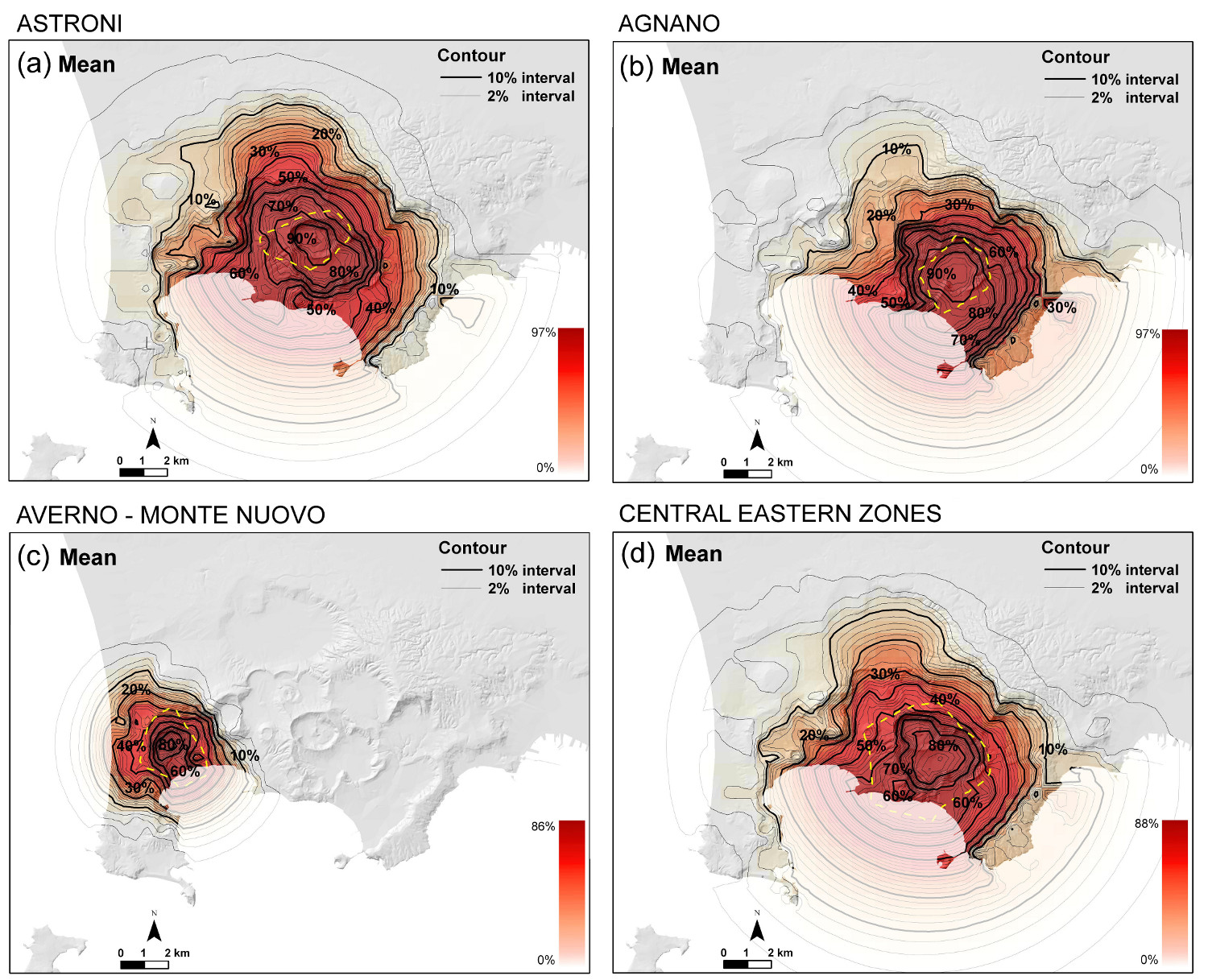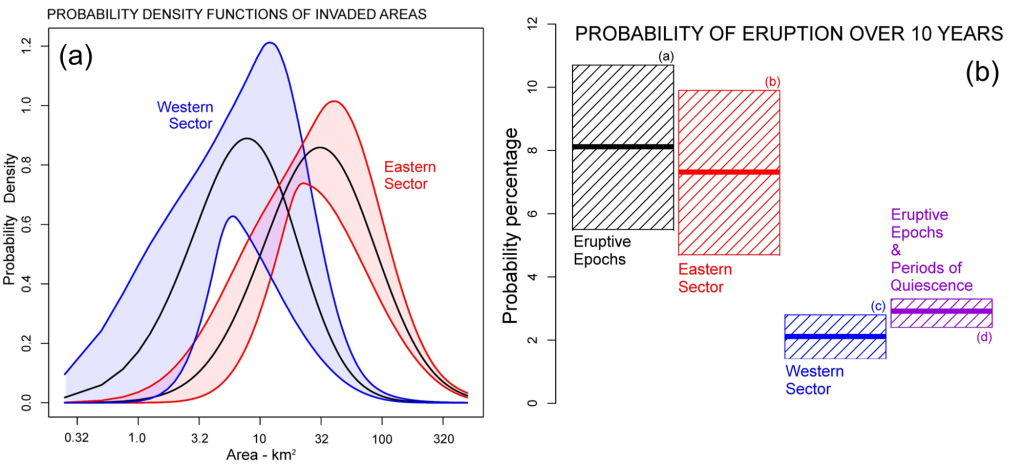Database of pyroclastic density current hazard maps at Campi Flegrei caldera (Italy): doubly stochastic application of a box-model approach on the long-term vent opening map

Data grids are projected in UTM WGS84 coordinate system, Zone 33 N.
Andrea Bevilacqua and Augusto Neri
Istituto Nazionale di Geofisica e Vulcanologia, Sezione di Pisa, Pisa, Italy
https://doi.org/10.13127/campi-flegrei/pdc-hazard-maps
This database collects several long-term hazard invasion maps for pyroclastic density currents (PDC) originating at Campi Flegrei caldera (Italy), produced under selected different assumptions. The maps are fully described in the scientific paper by Bevilacqua et al. (2017) and are available in the Database as standard geo-referenced ascii files easily imported in a Geographical Information System. More maps and details on how the maps were produced are described in Neri et al. (2015).
The applied method statistically combines different types of data, through their respective probability distributions, and the application of a simplified PDC invasion model. These are: (1) probability maps of vent opening of the caldera to determine the location of the next eruptive vent (Bevilacqua et al. 2015); (2) probability distributions of the scale of the next pyroclastic flow event here represented by the reconstructed PDC invasion areas of past events (Neri et al. 2015; Bevilacqua et al., 2017); (3) an integral kinetic flow model to conduct a large number of simulations by varying vent location, eruptive scale, and time horizon (Esposti Ongaro et al., 2016; Aravena et al., 2022); (4) a spatio-temporal probability model of the next eruption, capable of describing clusters of events both in space and time (Bevilacqua et al., 2016).
Such method is based on a doubly stochastic approach, i.e., a structured procedure that distinguishes between the epistemic sources of uncertainty (due to the lack of knowledge) and the aleatoric sources of uncertainty (due to the physical variability of the modeled processes), by calculating confidence intervals on the probability outputs. This approach is applied on several of the key uncertainty sources such as the spatial location of the volcanic vent, the size of the flow and the expected time of such an event. As a result, mean and percentile maps of PDC invasion probability are produced.
For example, Figure 1 shows hazard invasion maps with the eruptive vent in specific zones of the caldera, and assesses how the vent location scenarios could affect the PDC invasion hazard. It is important to underline that these maps are conditional on the occurrence of an eruption with a vent on-land and that the statistical analysis is based on data referring to the last 15 kyr. From this point of view, the presented maps can be considered medium-long term hazard maps. Vice versa, short-term hazard maps, i.e. considering time horizons of the order from hours to weeks, would require the integration of available monitoring data and field observations and the development of more accurate models of the expected pre-eruptive and eruptive processes.
Figure 2a shows that the statistics of the eruptive scale here represented by the pyroclastic flow invasion area over the past 15 ka. The plot shows that the activity has been significantly greater (in both scale and frequency) in the eastern sector of the caldera, compared to the western sector (the E14°12′ meridian was assumed as the separation line). Therefore, PDC hazard maps that distinguish between the western and eastern sectors highlight a significantly higher level of PDC hazard to the east.
Notably, Campi Flegrei eruptions are distributed in epochs of activity alternating to millennia of quiescence, and the activity is significantly clustered also at the scale of tens/hundreds of years. In Figure 2b the probability of the next eruption over the next 10 years has been estimated by using a self-exciting statistical model (Cox-Hawkes model, Bevilacqua et al., 2016). From the figure it is evident that the estimates that assume the most recent eruption, i.e., the 1538 CE Monte Nuovo event, marked the beginning of a new eruptive epoch are greater by a factor of 3 than those that are not making such assumption. Note that these estimates do not significantly change with passing time, if no eruption occurs, and remain valid for the next 10 years.
Conditional maps representative of PDC with a limited range of scales are also produced, to explore specific size scenarios. These maps are fully described in the Bevilacqua et al. (2017) and the name of the files indicates the specific figure showing them in that study.

References
- Aravena A., A. Bevilacqua, M. de’ Michieli Vitturi, T. Esposti Ongaro, A. Neri., R. Cioni, (2022). Calibration strategies of PDC kinetic energy models and their application to the construction of hazard maps. Bull. Volcanol., 84, 29. doi: 10.1007/s00445-022-01538-8
- Bevilacqua A., R. Isaia, A. Neri, S. Vitale, et al., (2015). Quantifying volcanic hazard at Campi Flegrei caldera (Italy) with uncertainty assessment: I. Vent opening maps, J. Geophys. Res. Solid Earth, 120 (4), 2309-2329. doi: 10.1002/2014JB011775.
- Bevilacqua A., F. Flandoli, A. Neri, R. Isaia, and S. Vitale, (2016). Temporal models for the episodic volcanism of Campi Flegrei caldera (Italy) with uncertainty quantification. J. Geophys. Res. Solid Earth, 121, doi:10.1002/2016JB013171.
- Bevilacqua A., A. Neri, M. Bisson, T. Esposti Ongaro, F. Flandoli, R. Isaia, M. Rosi, and Vitale S., (2017). The Effects of Vent Location, Event Scale, and Time Forecasts on Pyroclastic Density Current Hazard Maps at Campi Flegrei Caldera (Italy). Front. Earth Sci. 5:72. doi: 10.3389/feart.2017.00072
- Neri A., A. Bevilacqua, T. Esposti Ongaro, R. Isaia, et al. (2015), Quantifying volcanic hazard at Campi Flegrei caldera (Italy) with uncertainty assessment: II. Pyroclastic density current invasion maps, J. Geophys. Res. Solid Earth, 120 (4), 2330-2349. doi: 10.1002/2014JB011776
- Esposti Ongaro T., S. Orsucci, F. Cornolti, (2016). A fast calibrated model for pyroclastic density currents kinematics and hazard, J. Volcanol. Geoth., Res. 327, 257-272.


Devi effettuare l'accesso per postare un commento.